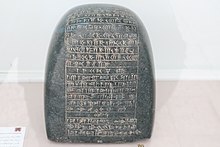Stone (unit)
England and other Germanic-speaking countries of Northern Europe formerly used various standardised "stones" for trade, with their values ranging from about 5 to 40 local pounds (2.3 to 18.1 kg) depending on the location and objects weighed.4. c. 74), which applied to all of the United Kingdom of Great Britain and Ireland, consolidated the weights and measures legislation of several centuries into a single document.used for beeswax, sugar, pepper, alum, cumin, almonds,[16] cinnamon, and nutmegs;[17] stones of 12 lb.[16][17] In 1350 Edward III issued a new statute defining the stone weight, to be used for wool and "other Merchandizes", at 14 pounds,[nb 2] reaffirmed by Henry VII in 1495.In 1661, the Royal Commission of Scotland recommended that the Troy stone be used as a standard of weight and that it be kept in the custody of the burgh of Lanark.The Board of Trade, on behalf of the government, agreed to support a ten-year metrication programme.In many sports in both the UK and Ireland, such as professional boxing, wrestling, and horse racing,[39] the stone is used to express body weights.[41] Before the advent of metrication, units called "stone" (German: Stein; Dutch: steen; Polish: kamień) were used in many northwestern European countries.This table shows a selection of stones from various northern European cities: In the Netherlands, where the metric system was adopted in 1817, the pond (pound) was set equal to half a kilogram, and the steen (stone), which had previously been 8 Amsterdam pond (3.953 kg), was redefined as being 3 kg.



Rock (geology)Stone (disambiguation)bronzeEnglish coat of armsUnit systemBritish imperialEnglishBritish imperial unitavoirdupoispoundsbody weightEnglandGermanicNorthern EuropemetricationDarius the GreatEschbornRoman poundsBiblical lawRoman poundYale Medical LibraryserpentineEncyclopædia BritannicaWeights and Measures Act 18245 Geo. 4United Kingdom of Great Britain and IrelandWeights and Measures Act 1835English stoneAssize of Weights and Measuresstatute of uncertain datemerchants' poundsbeeswaxpepperalmondscinnamonnutmegsEdward IIIHenry VIIslide ruleOxford English DictionaryScottish stoneLanarkEdinburghBelfastavoirdupois poundsCounty ClareFederation of British IndustryBoard of TradeMetrication BoardDirective 80/181/EECEU internal marketWeights and Measures Act 1985British EmpireThomas JeffersonSecretary of Statereport on weights and measuresU.S. House of RepresentativesGermanPolishDresdenMecklenburg-StrelitzBerlinGdańskKaliningradWrocławPragueSolothurnStockholmWarsawVilniusViennakilogramAmsterdam pondimperialGerman units of measurementInternational Yard and Pound AgreementUnited Kingdommetric systemUnited States. National Bureau of StandardsWayback MachineWeights and Measures Act of 1963National Institute of Standards and TechnologyRuffhead, Owen25 Edw. 3Weights and Measures Act 149511 Hen. 7Parliamentary Debates (Hansard)legislation.gov.ukThe National ArchivesBartlett, JamesChisholm, HughWikisource1911 Encyclopædia BritannicaImperial unitsComparison with US customary systemThousandth of an inchBarleycornFathomGunter's chainFurlongNautical mileLeagueSquare inchSquare footSquare yardSquare mileCubic inchCubic footHoppusCubic yardCubic mileTeaspoonTablespoonFluid ounceTrade gallonGallonChaldronFluid ScrupleFluid DrachmBushelBarrelHogsheadMiles per hourDrachmPound (mass)Quarter